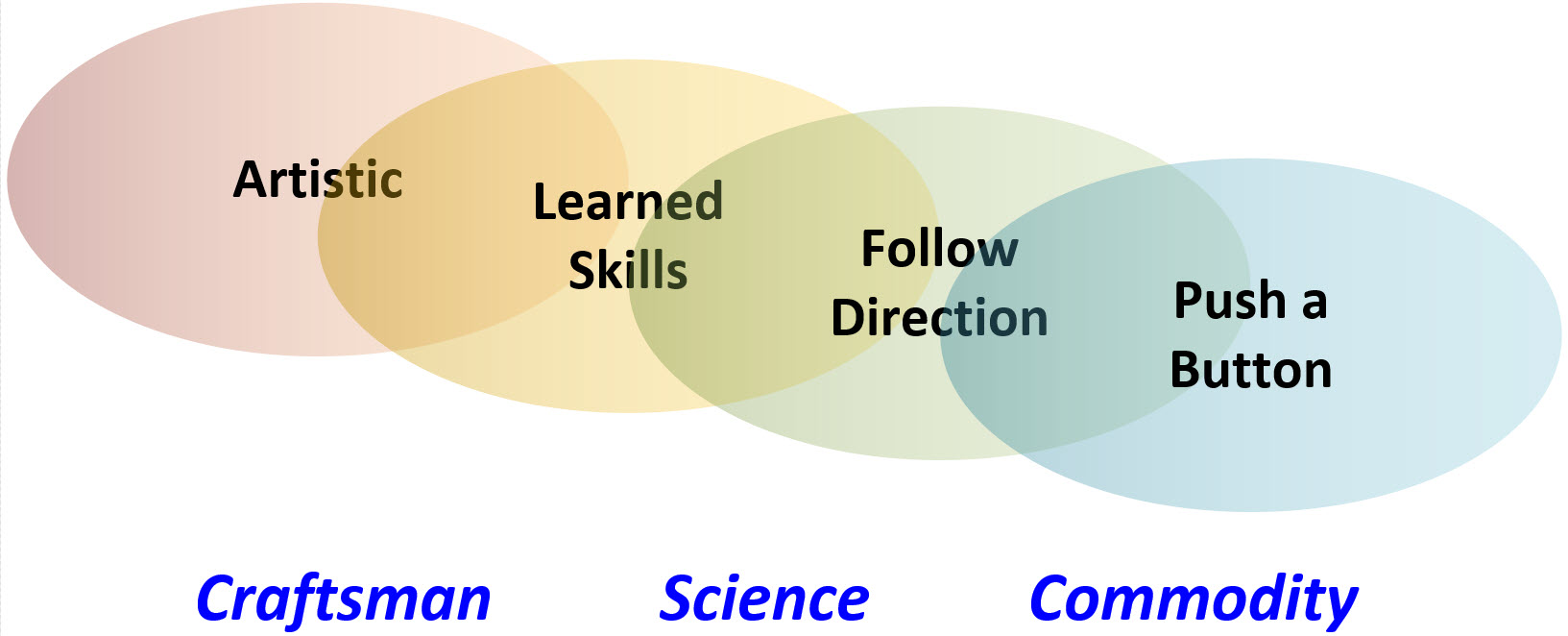By Larry Danberger February 2, 2018
Now in my third decade of professional servitude to the Information Age, I look back with both fondness and sadness to the experiences, opportunities, accomplishments, and failures that I have been involved in or have observed from near and afar. Patterns which become evident over time and across domains can be enlightening, concerning and amusing at the same time.
One such pattern that is certainly not unique to the Information Age, is the progression from Craftsmanship to Science to Commodity. This can be applied at any level of an organization from creation of the organization at the 50,000 foot level to the activities of an individual worker. This can also be applied to our everyday lives, as evident in the pursuit of ability and knowledge to produce improved personal life results such as music, art, happy home life and relationships. Understanding and communicating where we are within any given subject matter (domain) will help identify values, actions, risks and benefits, and will help with team alignment.

Craftsman
Can be another name for the intersection between mystical artistic abilities and learned skills of the laborer; a nature vs. nurture debate that continues in many pubs and classrooms. It is the ability to create great results (a tangible or intangible product).
Science
As the production of the craftsman’s desired result is examined, techniques and instructions emerge whereby others can be trained to reproduce the same or similar results. This systematic approach represents the progression from Craftsmanship to Science while also reducing further the reliance on ‘natural’ abilities within the Craftsmanship stage, the intersection mentioned earlier.
Commodity
With the creation of the desired product now well understood and easily reproducible via Science, a form of mass production emerges and eventually a shift occurs where production is combined and embedded into new products, obscuring the creation further and completing the progression to Commodity where its existence or ease of creation is merely taken for granted.
Risks and Benefits
The required level of individual artistic ability, training, and knowledge decreases as we progress from Craftsmanship to Commodity. Likewise the time, costs, and efforts are reduced. The tradeoff is the loss of the individualized fit or uniqueness. Also lost is the unique quality of the product and unique experience of the craftsman, honing skills to produce superior products to be proud of.
At the Commodity stage, the Craftsmanship and Science stages have been removed, obscured and perceived as no longer needed by most. There is now a blind trust that the new products and services will work as the consumers have grown to demand, and there is little investment in the skills and knowledge that was utilized within the Craftsmanship and Science stages.
This can be a good thing, usually. I don’t need to know how an airplane works, in order to fly to a different location. It just works. Likewise the magic behind radio and television doesn’t matter, I just use it and trust that it does the job. This black box approach is how our society progresses, we build upon and utilize the accomplishments of others.
But what happens when we move too fast to commodity? We get major headaches and crashes. The dot-com crash. The CDO crash. Software viruses. Ransomware. Disorganized businesses. Project overruns. These are all arguably the result of product consumers not understanding what they were using, the result of products perceived too quickly to be in the Commodity stage where subject matter knowledge and skill are deemed unnecessary. The knowledge to understand the dangers, and to use it right, was not there.

